Telangana TSBIE TS Inter 2nd Year Zoology Study Material Lesson 1(a) Digestion and Absorption Textbook Questions and Answers.
TS Inter 2nd Year Zoology Study Material Lesson 1(a) Digestion and Absorption
Very Short Answer Type Questions
Question 1.
Give the dental formula of adult human [March 2015 (T.S.)]
Answer:
Dental formula of adult human being is = \(\frac{2123}{2123}\)

Question 2.
Bile juice contains no digestive enzymes, yet it is important for digestion. How?
Answer:
Bile salts of the bile help in the emulsification of fats (breakdown of fats into very small micelles). Bile also activates lipases of pancreatic juice (Steapsin) and intestinal lipases.
Question 3.
Describe the role of chymotrypsin. Name two other digestive enzymes of the same category and secreted by the same gland.
Answer:
Chymotrypsin acts upon proteins, proteoses and peptones to convert them into tripeptides and dipeptides.
Two other digestive enzymes of the same category and secreted by the same gland pancreas are a) trypsin b) carboxypeptidase.
Question 4.
What would happen if, HCl were not secreted in the stomach?
Answer:
HCI secreted by gastric glands in stomach provides the acidic pH (1.8) which is optimal for the action of pepsin. It also kills the microorganisms ingested along with food. Pepsinogen and prorenin are not activated if HCI were not secreted in the stomach.
Question 5.
Explain the terms thecodont and diphyodont dentitions.
Answer:
- Teeth of human beings are embedded in the sockets of the Jaw bones, hence called thecodont.
- Human beings form two sets or teeth during their life time, milk set and permanent adult teeth. This type of dentition is called diphyodont dentition.
![]()
Question 6.
What is auto catalysis? Give two examples.
Answer:
Trypsinogen is activated by the enzyme enterokinase into active trypsin which inturn can activate trypsinogen into trypsin it is called auto catalysis. Another such example is Pepsin.
Question 7.
What is chyme? [March 20191 May 2017 (A.P.)]
Answer:
The food is mixed thoroughly with the acidic gastric Juice of the stomach by the churning movements of its muscular wall and the product is called Chyme. (The semi digested paste like acidic food of stomach is called chyme).
Question 8.
Name the different types of salivary glands of man, and their locations in the human body. [March 2020]
Answer:
There are 3 pairs of salivary glands of Man.
- Parotid glands – present below the pinna and inner surface of cheeks.
- Sub maxillary glands-located at the angles of lower jaw.
- Sub lingual glands – present below the tongue.
Question 9.
Name different types of papillae present on the tongue of man. [March 2019, May 2017 (A.P.)]
Answer:
The different types of papillae present on the tongue of Man are a) fungi form b) filiform c) circumvallate papillae.
Question 10.
What is the hardest substance in the human body? What is its origin?
Answer:
The hardest substance in the body is enamel which is secreted by ameloblasts of ectodermal origin.
Question 11.
Name the structure of gut which is vestigial in human beings, but well developed in the herbivores and mention the type of tissue with which it is mostly formed.
Answer:
Structure of gut which is vestigeal in human beings is Vermiform appendix arises from the caecum, it is mostly formed from epithelial tissue.
Question 12.
Distinguish between deglutition and mastication.
Answer:
- Deglutition is swallowing of food facilitated by buccal cavity.
- Mastication is chewing. Teeth and tongue with the help of saliva masticate and mix up the food thoroughly.
![]()
Question 13.
Distinguish between diarrhoea and constipation.
Answer:
a) Diarrhoea :
The abnormal frequency of bowl movement and increased liquidity of the faecal discharge is known as diarrhoea. It results in loss of water (dehydration).
b) Constipation :
In constipation, the faeces are retained with in the rectum as it is hard due to low content of water and the movement of the bowel occurs irregularly.
Question 14.
Name two hormones secreted by the duodenal mucosa.
Answer:
Two hormones secreted by duodenal mucosa.
- Enterocrinin
- Secretin
- Cholecystokinin.
Question 15.
Distinguish between absorption and assimilation.
Answer:
- Absorption is the process by which the end products of digestion pass through the intestinal mucosa into blood or lymph.
- The absorbed substances finally reach the tissues where food materials become integral components of the living protoplasm and are used for the production of energy, growth and repair. This process is called assimilation.
Short Answer Type Questions
Question 1.
Draw a neat labelled diagram of L.S. of tooth. [Mar. ’20, 19, 18,17,14 (A.P.); May/June ’14]
Answer:
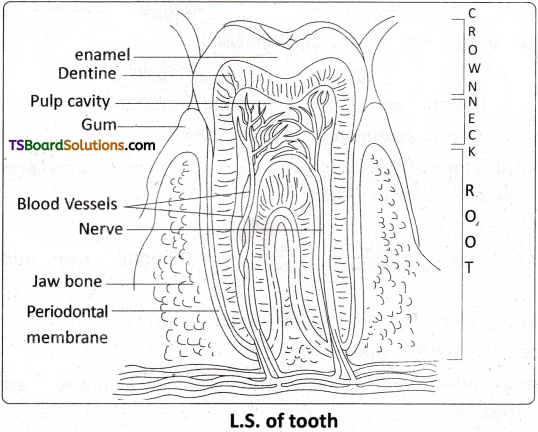
Question 2.
Describe the process of digestion of proteins in the stomach. [March 2015 (A.P.)]
Answer:
The gastric glands of stomach secrete acidic gastric juice. Gastric juice contains HCl, prorennin, pepsinogen and bicarbonates.
Proenzymes pepsinogen and prorennin, on exposure to HCl, are converted into the active enzymes, pepsin and rennin respectively.
Pepsin converts proteins into proteoses and peptones. Rennin is found in gastric juice of infants. It acts on milk protein casein in the presence of calcium ions and converts it into calcium paracaseinate (curd) and proteoses. Pepsin again acts on calcium para- caseinate and converts it into peptones. Certain other cells in the wall of stomach produce bicarbonate, a base to buffer the acidic contents of the stomach. Bicarbonates and mucus produced by stomach wall forms a physical barrier to prevent HCl from damaging the wall of stomach.
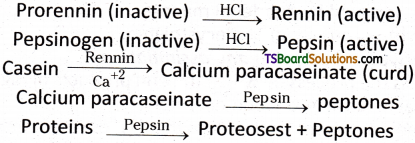
Question 3.
Explain the role of Pancreatic Juice in the digestion of proteins.
Answer:
Pancreatic juice contains sodium bicarbonate, trypsinogen, chymotrypsinogen, carboxypeptidase, pancreatic lipase (steapsin), pancreatic amylase and nucleases such as DNA ase and RNA ase.
Trypsinogen is activated by an enzyme enterokinase into active trypsin which in turn activates the other enzymes in the pancreatic juice. Trypsin itself can similarly activate trypsinogen into trypsin (autocatalysis).

Proteolytic enzymes of the pancreatic juice act upon proteins, proteoses and peptones when they reach intestine.

Thus the end products of digestion of proteins namely amino acids are formed in the small intestine.
![]()
Question 4.
How are polysaccharides and disaccharides digested?
Answer:
Polysaccharides are nothing but carbohydrates. Carbohydrates in the chyme are hydrolysed by the pancreatic amylase into disaccharides. Intestinal disaccharidases act on the disaccharides and convert them into monosaccharides like Glucose etc.

Question 5.
If, you take butter in your food, how does it get digested and absorbed in the body? Explain.
Answer:
- Butter is a content of macromolecules and is fat or lipid.
- Bile salts of the bile help in breaking down of large fat molecules into very small micelles. This process is called Emulsification. They move into intestinal mucosal cells.
- These micelles are reformed into very small protein coated fat globules called chylomicrons which are transported into the lacteals in the villi by exocytosis.
- Bile also activates lipases of pancreatic juice (steapsin) and intestinal lipases. These lipases act on emulsified fats and convert them into fatty acids and glycerols.

Question 6.
What are the functions of liver? [May 2017 (A.P.); March 2015 (T.S.)]
Answer:
Functions of the liver :
Liver performs a variety of functions such as synthesis, storage and secretion of various substances. There are as follows :
- Liver secretes bile juice. It does not contain enzymes, but it contains bile salts such as glycocholates and taurocholates of sodium and potassium and ‘bile pigments’ the bilirubin and biliverdin.
- Liver plays the ‘key role’ in carbohydrate metabolism (glycogenesis, glycogenolysis, gluconeogenesis and lipogenesis).
- Liver also plays a role in lipid metabolism (synthesis of cholesterol and production of triglycerides).
- Deamination of proteins (removal of NH2 group from the amino acids) and conversion of ammonia into to urea – via the ornithine cycle).
- The lactic acid formed during anaerobic muscle contraction is converted into glycogen (gluconeogenesis) in the liver by Cori cycle.
- Liver is the chief organ of detoxification of toxic substances that enter the gut along with food.
- Liver acts as thermoregulatory organ (like skeletal muscle, liver too takes part in thermogenesjs as it has high glucose at its disposal).
- Liver acts as a haemopoietic organ in the foetus and erythroclastic organ in the adult.
- The liver synthesizes the plasma proteins such as albumins, globulins, blood clotting factors such as fibrinogen, prothrombin, etc., and the anticoagulant, called heparin.
- Kupffer’s cells/ Kupffer cells are the large phagocytic cells which remove unwanted substances and microbes that attack the liver by phagocytosis. They are present in the sinusoids that lie in between hepatic cords and they are also called hepatic macrophages.
Long Answer Type Questions
Question 1.
Describe the physiology of digestion of various types of food in the human digestive system.
Answer:
Physiology of digestion :
Digestion is the process of conversion of complex non – diffusible food substances into simple diffusible forms. The process of digestion is accomplished by mechanical (cutting and chewing of food by teeth and churning of food by peristalsis) and chemical (enzymatic reactions by hydrolysing enzymes) processes.
![]()
i) Digestion in the buccal cavity :
Buccal cavity performs two major functions, mastication of food and facilitation of swallowing (deglutition). Teeth and tongue with the help of saliva masticate and mix up the food thoroughly. Mucus in saliva helps in lubricating and adhering the masticated food particles into a bolus. The saliva secreted into oral cavity contains electrolytes such as Na+, K+, Cl–, HCO–3 and enzymes, such as salivary amylase (ptyalin) and lysozyme. The chemical process of digestion is initiated in the oral cavity (buccal cavity) by the hydrolytic action of carbohydrate (starch) splitting enzyme, the salivary amylase. About 30% of starch is hydrolyzed here into a disaccharide called maltose by the enzyme ptyalin. Lysozyme present in the saliva acts as an antibacterial agent that prevents infections.
ii) Digestion in the stomach :
The stomach stores food for 4-5 hours. The food is mixed thoroughly with the acidic gastric juice of the stomach by the churning movements of its muscular wall and the product is called chyme. The mucus and bicarbonates present in the gastric juice play an important role in the lubrication and protection of the mucosal epithelium from ‘excoriation’ by the highly concentrated hydrochloric acid. HCl provides the acidic pH (1.8) which is optimal for the action of pepsin. It also kills the microorganisms ingested along with food. The proenzymes of gastric juice, the pepsinogen and prorennin, on exposure to hydrochloric acid are converted into the active enzymes pepsin and rennin respectively. Pepsin converts proteins into proteoses and peptones. Rennin is a proteolytic enzyme found in the gastric juice of infants.
It acts on the milk protein, the casein in the presence of calcium ions and converts it into calcium paracaseinate (curdling of milk) and proteoses. Pepsin acts on calcium paracaseinate and converts it into peptones. Proteoses are a group of compounds formed during protein digestion and they are more complex than peptones. Certain other cells in the wall of the stomach produce bicarbonate, a base, to buffer the acidic contents of the stomach. They also prevent too much acidity in the stomach. The mucus produced by the wall of the stomach forms a physical barrier to prevent HCl from damaging the wall of the stomach.
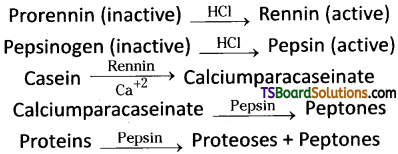
iii) Digestion in the small intestine :
Various types of movements are generated by the muscularis external layer of the small intestine. These movements help in thorough mixing up of the food with bile, pancreatic juice and intestinal juice in the intestine and thereby facilitate digestion. The mucus along with the bicarbonates from pancreas protects the intestinal mucosa from the acidic medium and provides an alkaline medium (pH 7.8) for enzymatic activities. The duodenal cells of the proximal part also produce large amounts of bicarbonate to completely neutralize any gastric acid that passes further down into the digestive tract. All the enzymes of the pancreatic juice and succus entericus (mentioned above) act only in alkaline medium.
i) Digestion of proteins :
Trypsinogen, chymotrypsinogen and procarboxy peptidases are inactive enzymes. Trypsinogen is activated by the enzyme, enterokinase, secreted by the intestinal mucosa into active trypsin, which in turn activates the other enzymes in the pancreatic juice. Trypsin itself can similarly activate trypsinogen into trypsin (autocatalysis).

Proteins, proteoses and peptones (partly hydrolysed proteins) in the chyme, reaching the intestine are acted upon by the proteolytic enzymes of the pancreatic juice and intestinal juice as shown below :

Thus the end products of digestion of proteins namely amino acids are formed in the small intestine.
ii) Digestion of fats:
Bile salts of the bile help in the emulsification of fats i.e., break down of fats into very small micelles. Bile also activates lipases of pancreatic juice (steapsin) and intestinal lipases. These lipases act on emulsified fats and convert them into fatty acids and glycerols.

iii) Digestion of Carbohydrates :
Carbohydrates in the chyme are hydrolysed by the pancreatic amylase into disaccharides. Intestinal disaccharidases act on the ‘disaccharides’ and convert them into monosaccharides.

iv) Digestion of nucleic acids :
Nucleases (DNAase, RNAase) of the pancreatic juice act on the nucleic acids to form nucleotides and nucleosides. Nucleotidases and nucleosidases of the intestinal juice convert the nucleotides and nucleosides into pentose sugars and nitrogen bases.

Question 2.
Explain the digestive system of man with neat labelled diagram.
Answer:
Digestive System :
Human digestive system consists of the alimentary canal and the associated glands.
Alimentary canal / digestive tract :
The alimentary canal of man begins with the anterior opening, the mouth and ends with the posterior opening, the anus. Parts of the alimentary canal between the mouth and the anus include buccal cavity, pharynx, oesophagus, stomach, small intestine and the large intestine in the given order.
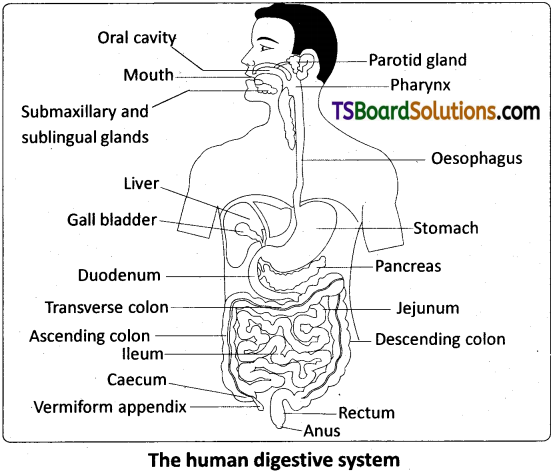
I. Mouth and Buccal (oral) cavity :
The mouth, bordered by the movable upper and lower lips (labia), leads into the buccal or oral cavity. The palate separates the ventral buccal cavity from the dorsal nasal chamber and facilitates chewing and breathing simultaneously. The anterior bony hard palate is lined by palatine rugae. The posterior soft palate that hangs down into the pharynx is called uvula. The jawbones bear four kinds of teeth and a tongue occurs at the base of the buccal cavity.
i) Teeth :
These are ecto-mesodermal in origin. Teeth of human beings are embedded in the sockets of the jaw bones – hence called thecodont. Majority of mammals including human beings form two sets of teeth during their life time, a set of temporary/milk or deciduous teeth replaced by a set of permanent or adult teeth. This type of dentition is called diphyodont dentition. An adult human has 32 permanent teeth, which are of four different types namely, incisors (I), canines (C), premolars (PM), and molars (M), and such a type of dentition is called heterodont dentition. The arrangement of different types of teeth in each half of both the jaws in the order I, C, PM, M is represented by the dental formula. In adult humans it is \(\frac{2123}{2123}\) = 32. The dental formula of the ‘milk dentition’ of a baby is \(\frac{2102}{2102}\) = 20 teeth. The third molar teeth appear very late (usually at about 21 years of age) and are called wisdom teeth. Incisors, the ‘chisel shaped’ teeth are useful in cutting, canines, the dagger like teeth help in tearing, premolars and molars, the cheekteeth, help in grinding the food.
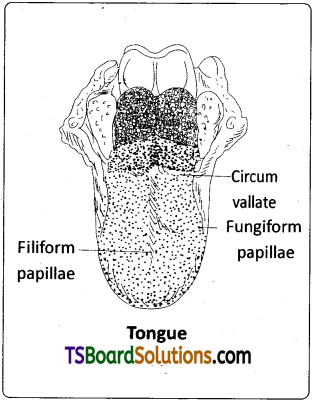
ii) Tongue :
It is a freely movable, muscular sense organ, attached to the floor of the oral cavity by a fold of tissue called frenulum. The upper surface of the tongue has small projections called papillae, some of which bear taste buds. In humans the tongue bears 3 types of papillae namely 1. fungi form (at the anterior margin and tip of tongue), 2. filiform (on the surface of the tongue) and 3. circumvallate papillae (on the posterior surface / base of the tongue). The tongue acts as ‘universal tooth brush’, and helps in mixing saliva with food, taste detection, deglutition and speaking.
II. Pharynx :
The oral cavity leads into a short pharynx which serves as a common passage for food and air. It is divided into nasopharynx (lies above the soft palate), oropharynx (the middle part) and laryngopharynx (the lower part) by the soft palate. Oesophagus and trachea open into the laryngopharynx. The trachea opens into the laryngopharynx through the glottis. A cartilaginous flap called epiglottis prevents the entry of food into glottis during swallowing. Pharynx possesses voluntary muscles to assist in swallowing. Tonsils (lymphoid tissues) present in the pharynx, include i) pharyngeal tonsil or adenoids, ii) a pair of palatine tonsils and iii) a pair of lingual tonsils.
III. Oesophagus :
The oesophagus is a thin long tube which extends posteriorly, passing through the neck, thorax and diaphragm and it finally leads into the stomach. A muscular sphincter (gastro – esophageal / cardiac sphincter) regulates the opening of the oesophagus into the stomach.
IV. Stomach :
The stomach is a wide, J – shaped, distensible muscular bag like structure, located in the upper left portion of the abdominal cavity just below the diaphragm. It has three major parts, an anterior cardiac portion into which the oesophagus opens, a middle large fundic region (main body) and a posterior pyloric portion which opens into the first part of the small intestine through the pyloric aperture which is guarded by the pyloric sphincter.
V. Small intestine :
The small intestine is the longest part of the alimentary canal. It is distinguished serially into three regions namely proximal duodenum, middle long coiled jejunum and distal highly coiled ileum. Duodenum receives the hepato – pancreatic duct. Ileum opens into the large intestine.
![]()
VI. Large Intestine :
It consists of caecum/colon and rectum. Caecum is a small blind sac which hosts some symbiotic microorganisms. A narrow finger – like tubular projection, the vermiform appendix (abdominal tonsil) which is a vestigial organ, arises from the caecum. The caecum opens into the colon which is divided into – an ascending, a transverse, a descending parts and a sigmoid colon that continues behind into the rectum. Colon shows the external bulged out pouches called haustra. Rectum is a small dilated sac which leads into anal canal that opens out through the anus.
It is guarded by an internal anal sphincter formed by ‘smooth muscle’ and external anal sphincter formed by a ring of voluntary, striped muscle. There is no significant digestive activity in the large intestine. It is concerned with the absorption of some water, minerals and certain drugs. It secretes mucus which helps in keeping the undigested particles together and lubricating its passage to the exterior.
Digestive glands :
The digestive glands present in the wall of the alimentary canal are gastric glands, Brunner’s glands, and crypts of Lieberkuhn. The salivary glands, liver and pancreas are the digestive glands associated with the gut (extra alimentary canal glands).